Charles E W Bean, Diaries, AWM38 3DRL 606/273/1 - 1918 - 1937 - Part 15
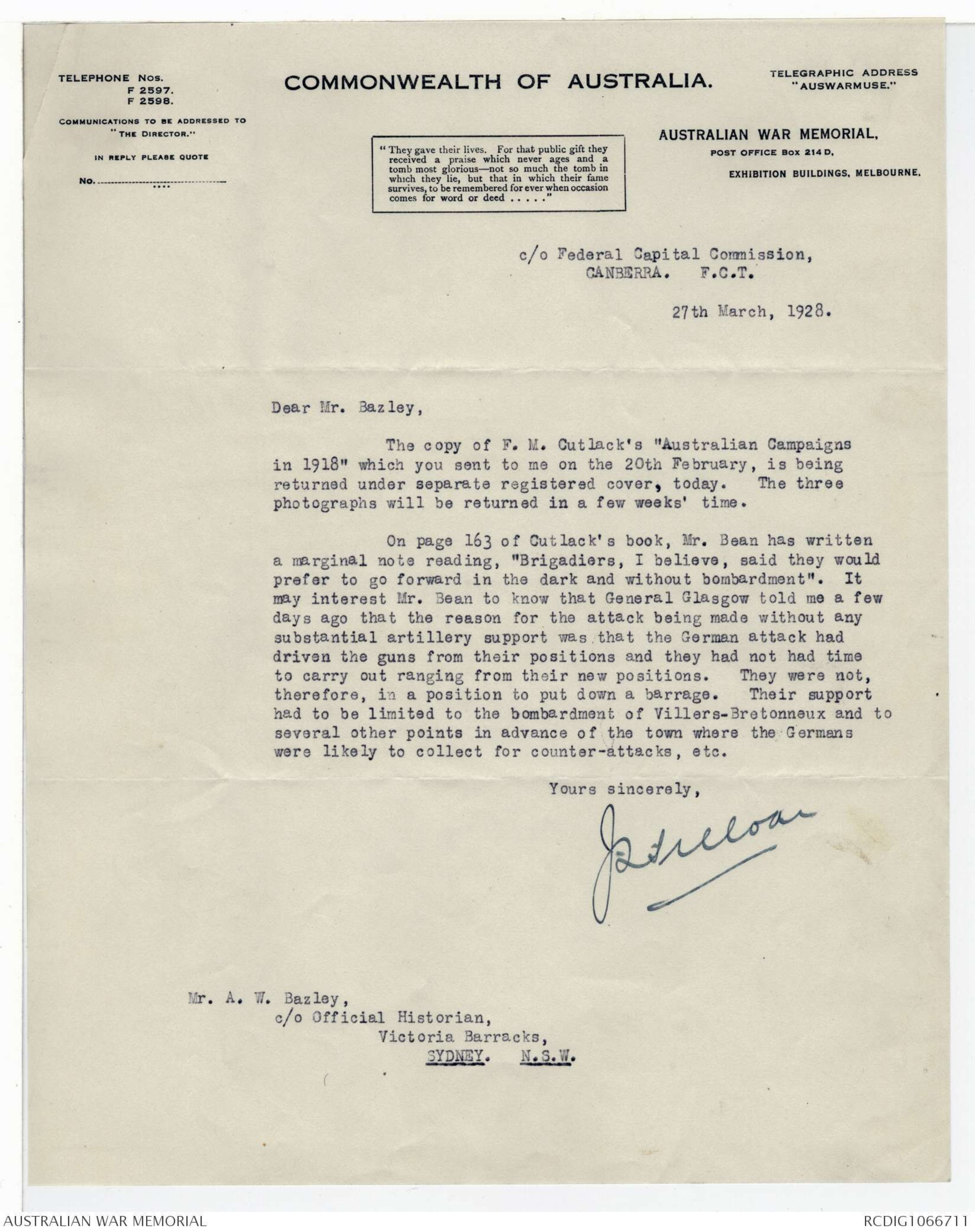
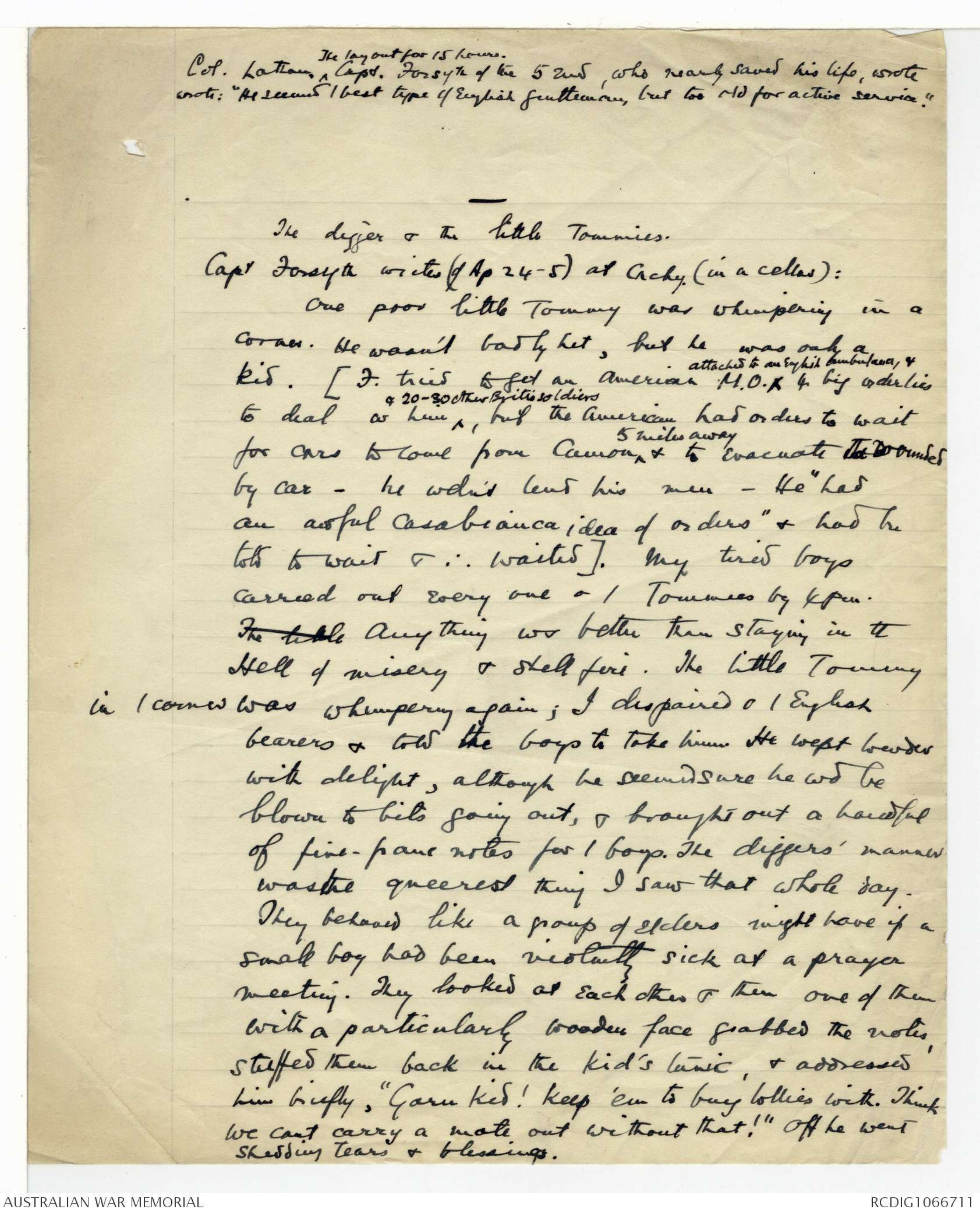
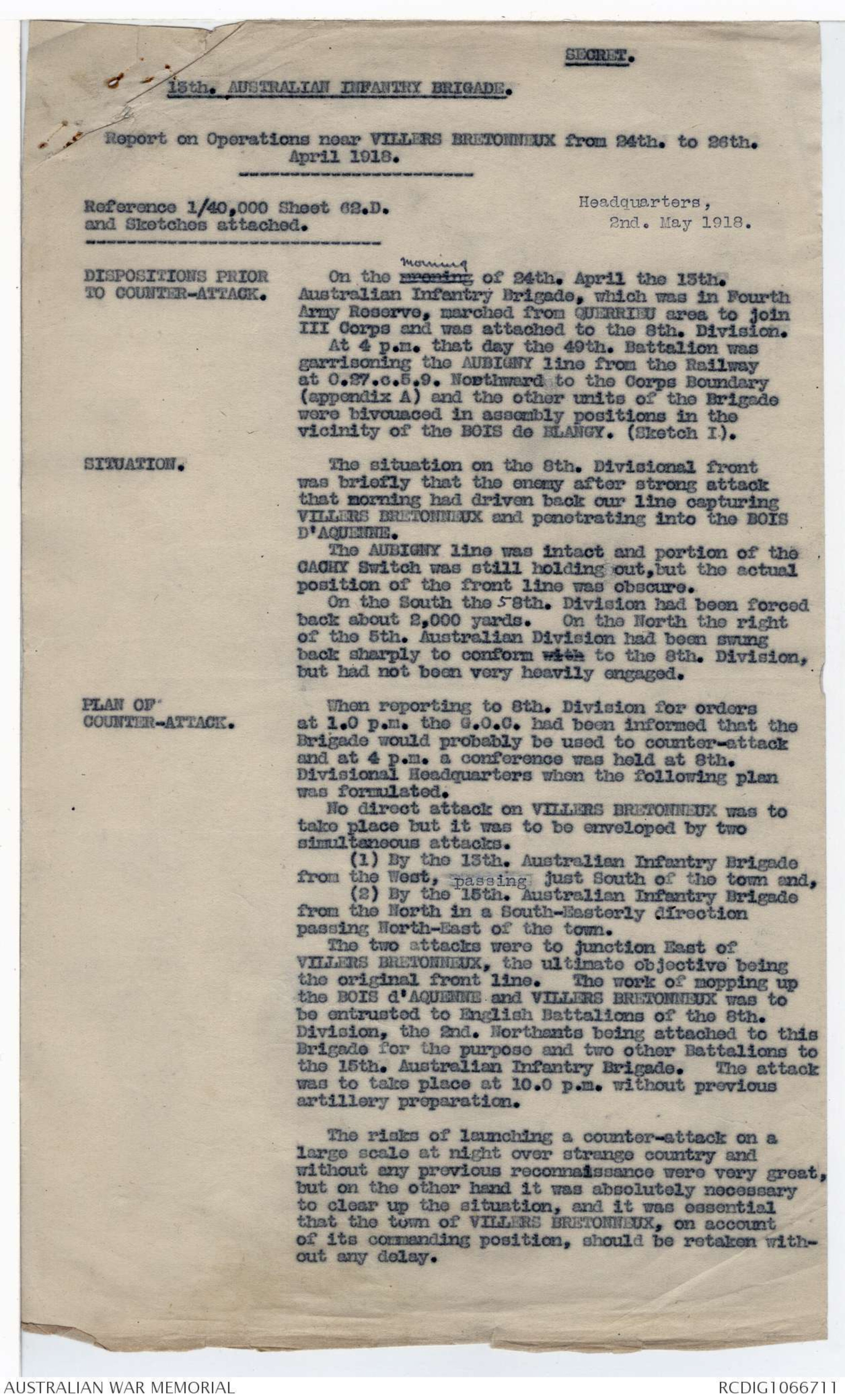

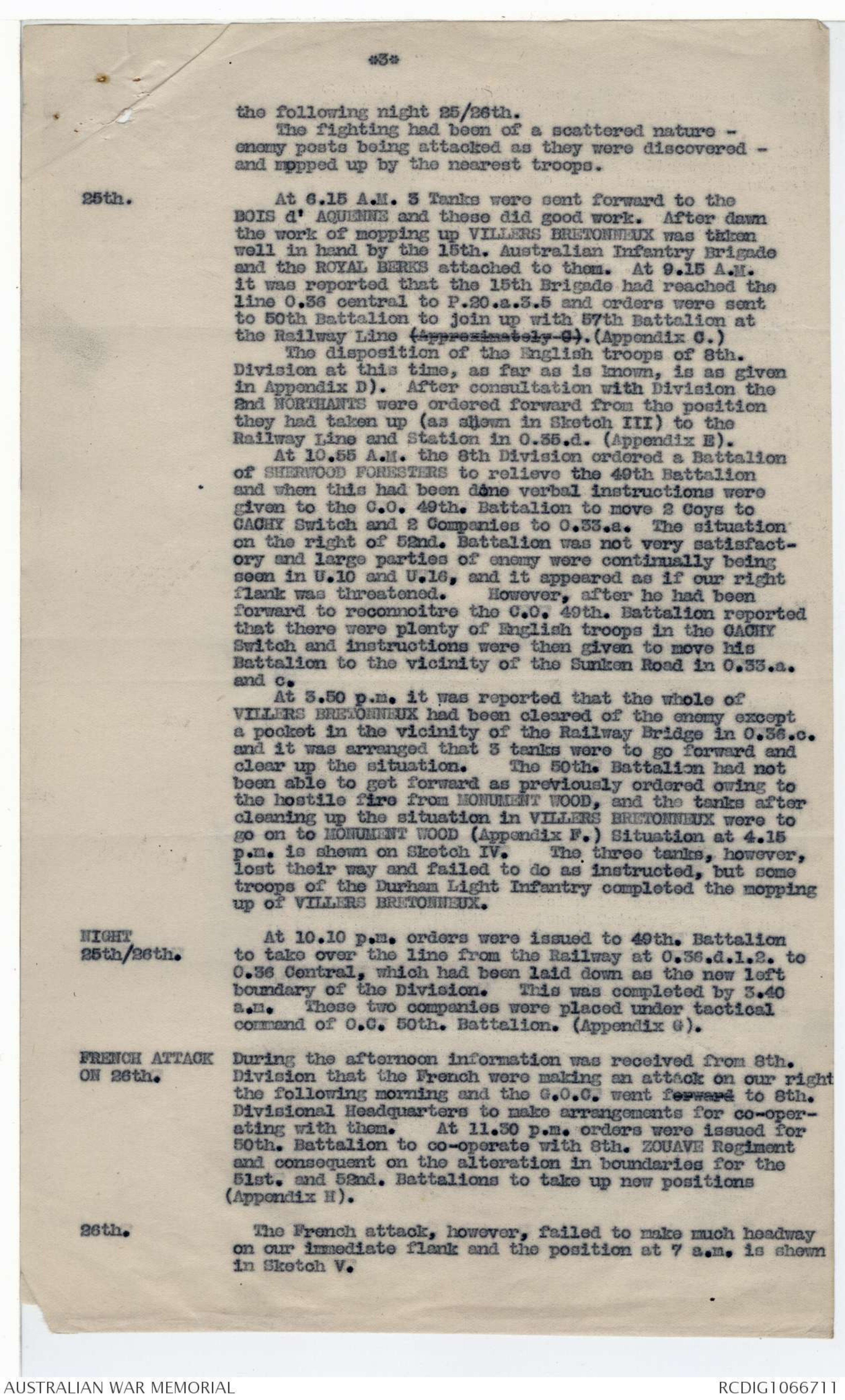
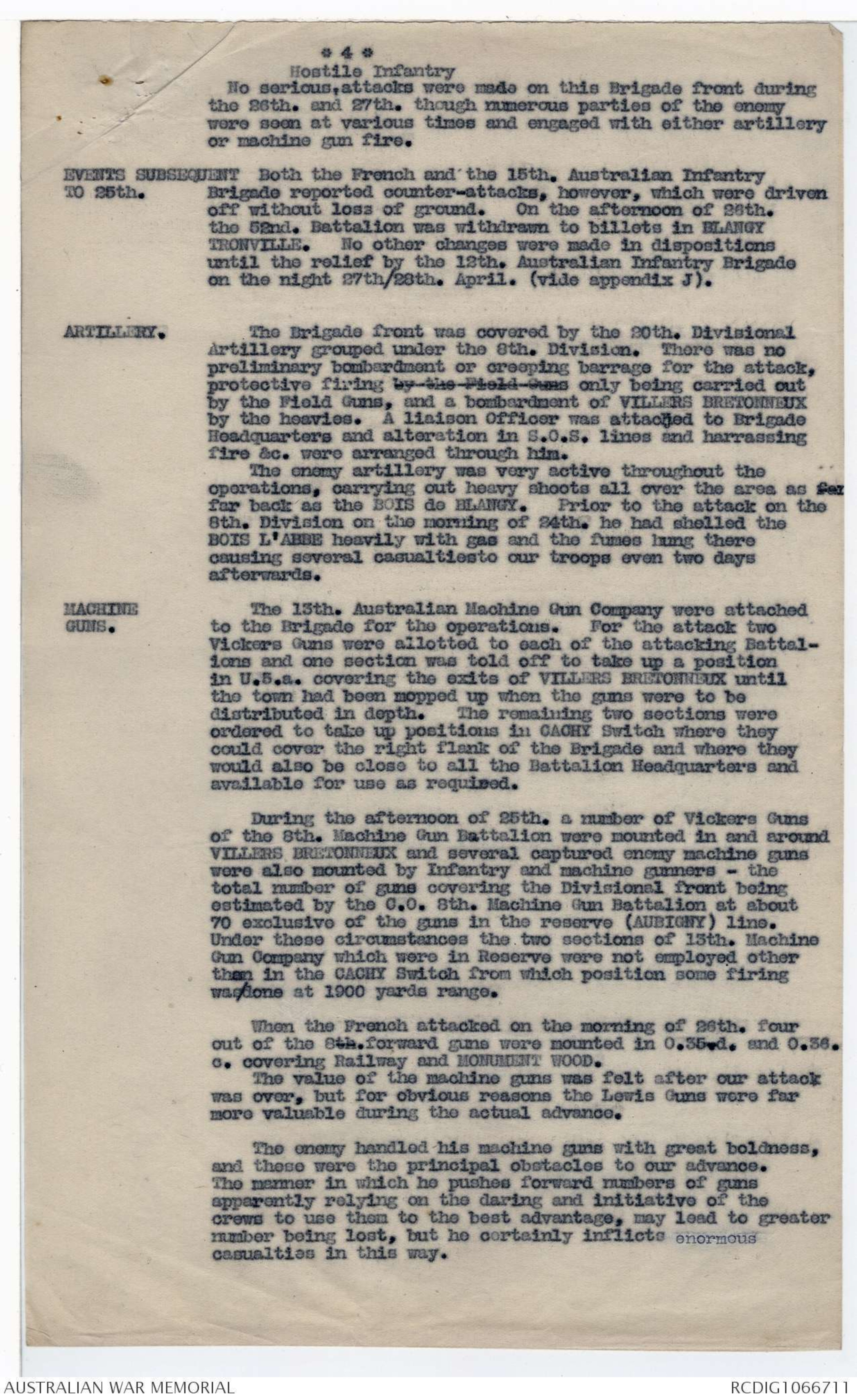
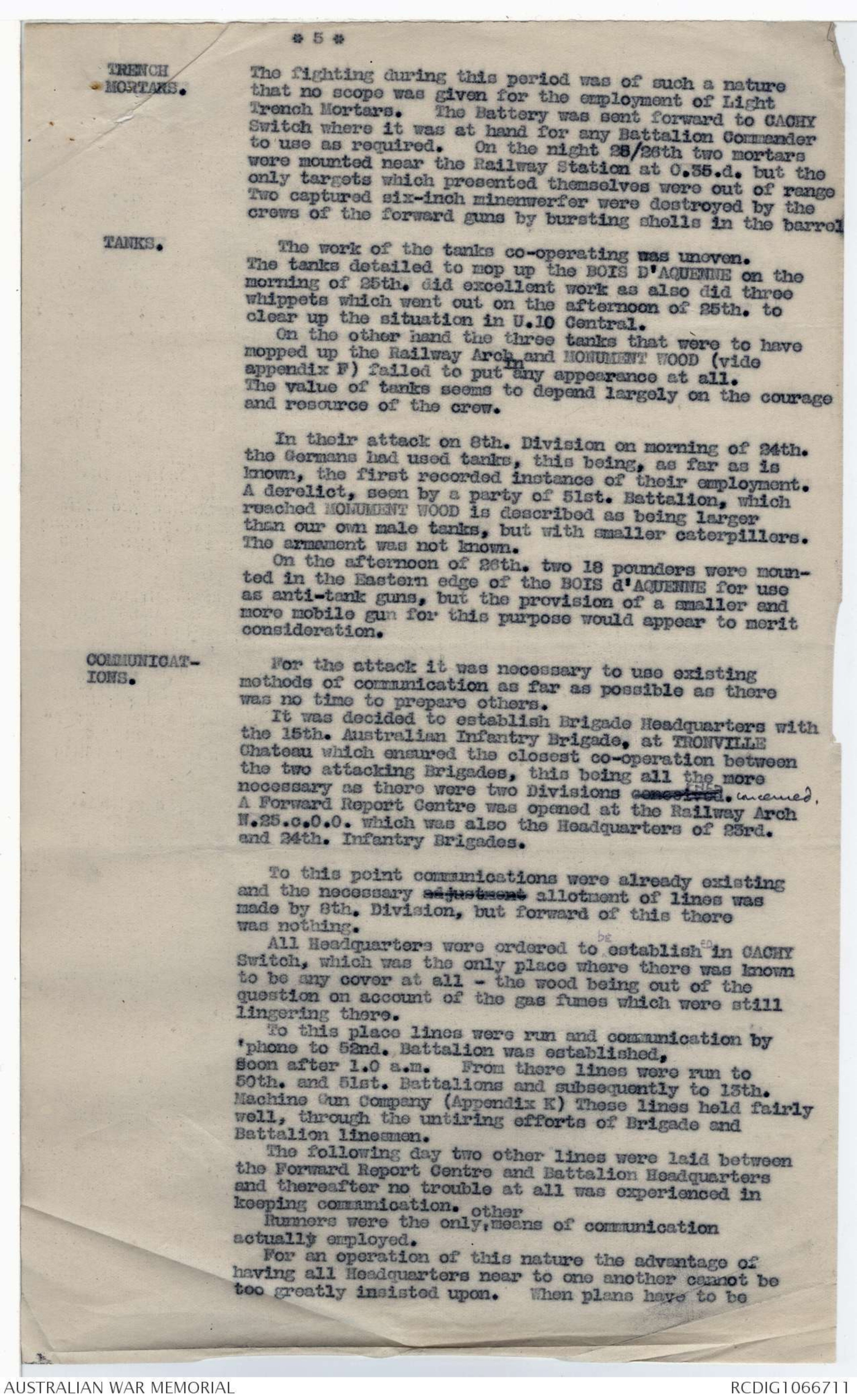
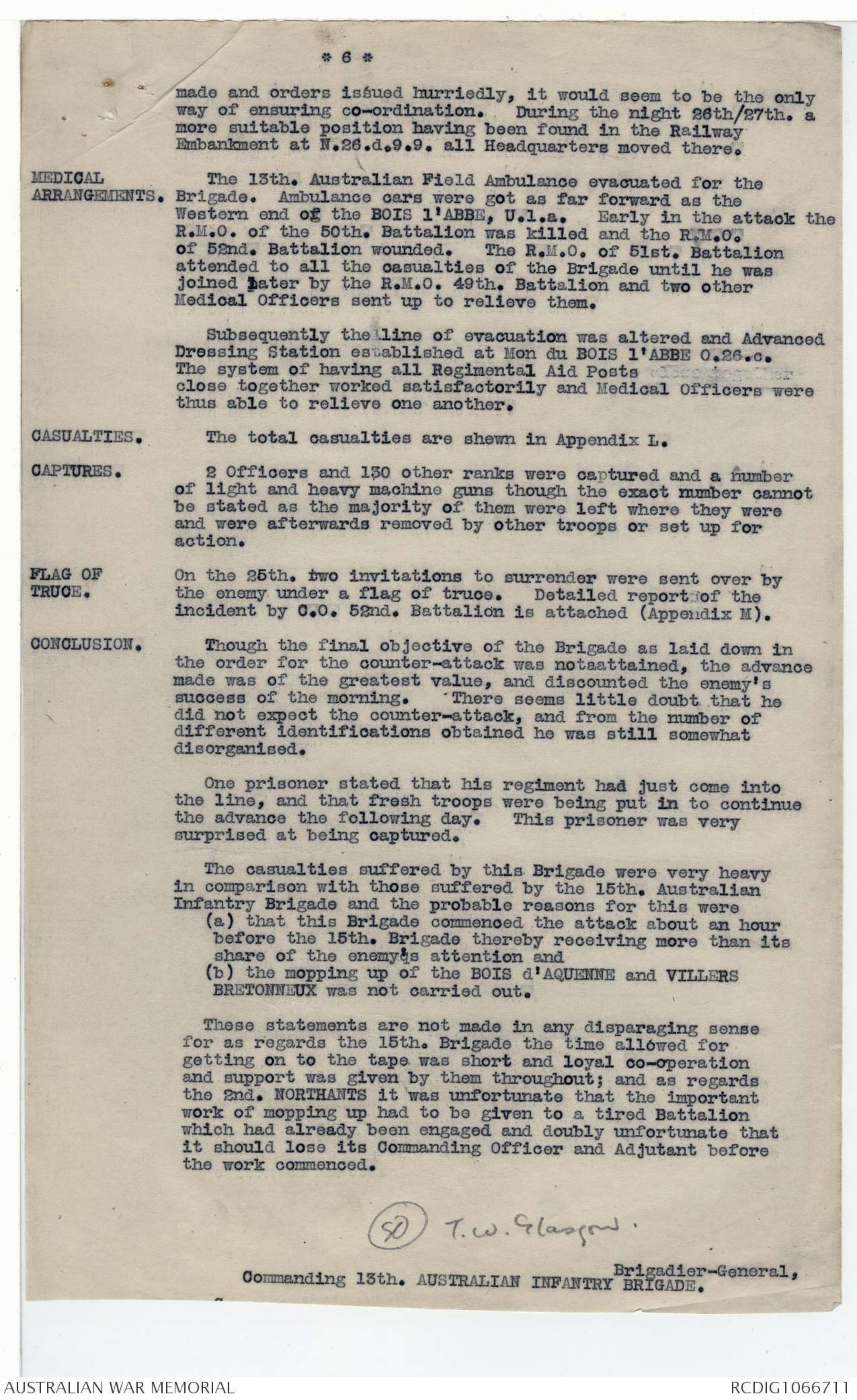
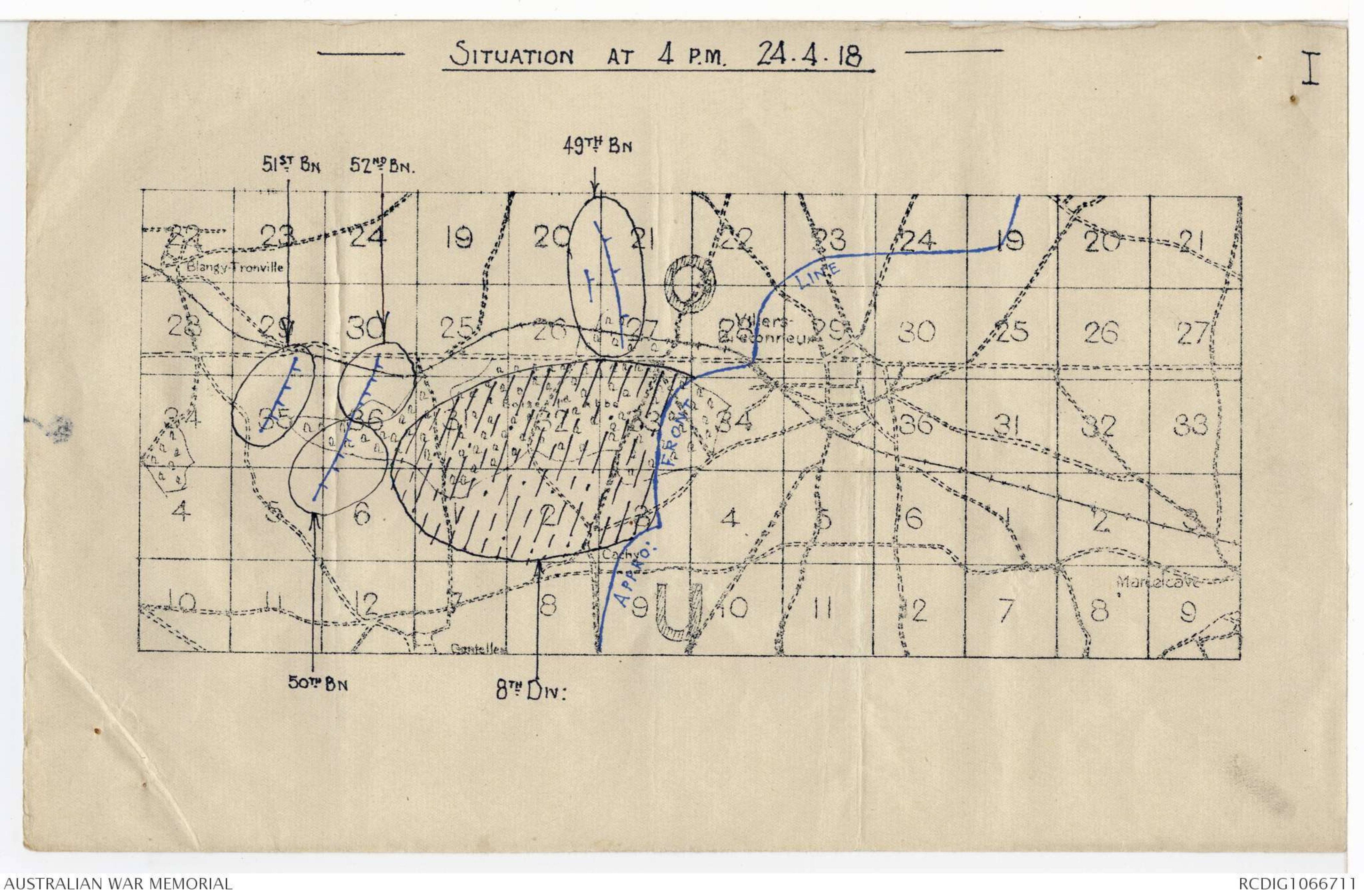

TELEPHONE Nos.
F 2597.
F 2598.
COMMUNICATIONS TO BE ADDRESSSED TO
"THE DIRECTOR"
IN REPLY PLEASE QUOTE
No.
TELEGRAPHIC ADDRESS
"AUSWARMUSE"
COMMONWEALTH OF AUSTRALIA.
AUSTRALIAN WAR MEMORIAL,
POST OFFICE BOX 241 D,
EXHIBITION BUILDINGS, MELBOURNE,
"They gave their lives. For that public gift they
received a praise which never ages and a
tomb most glorious —not so much the tomb in
which they lie, but that in which their fame
survives, to be remembered forever when occasion
comes for word or deed . . . ."
c/o Federal Capital Commission,
CANBERRA. F.C.T.
27th March, 1928.
Dear Mr. Bazley,
The copy of F. M. Cutlack's "Australian Campaigns
in 1918" which you sent to me on the 20th February, is being
returned under separate registered cover, today. The three
photographs will be returned in a few weeks' time.
On page 163 of Cutlack's book, Mr. Bean has written
a marginal note reading, "Brigadiers, I believe, said they would
prefer to go forward in the dark and without bombardment". It
may interest Mr. Bean to know that General Glasgow told me a few
days ago that the reason for the attack being made without any
substantial artillery support was that the German attack had
driven the guns from their positions and they had not had time
to carry out ranging from their new positions. They were not,
therefore, in a position to put down a barrage. Their support
had to be limited to the bombardment of Villers-Bretonneux and to
several other points in advance of the town where the Germans
were likely to collect for counter-attacks, etc.
Yours sincerely,
J. L. Treloar
Mr. A. W. Bazley,
c/o Official Historian,
Victoria Barracks,
SYDNEY. N.S.W.
Col. Latham. ^The layout for 15 hours. Capt Forsyth of the 52nd, who nearly saved his life, wrote
wrote: "He seemed / best type of English gentleman. but too old for active service."
The digger & the little Tommies.
Capt Forsyth writes (of Ap 24-5) at Cachy (in a cellar):
One poor little Tommy was whimpering in a
corner. He wasn't badly hit, but he was only a
kid. [F. tried to get an American M.O. ^attached to an English Ambulance & 4 big orderlies
to deal w him ^& 20-30 other British soldiers, but the American had orders to wait
for cars to come from Camon ^5 miles away & to evacuate the wounded
by car - he didn't lend his men - He "had
an awful Casabiauca idea of orders" & had bn
told to wait & ∴ waited]. My tired boys
carried out every one of the Tommies by 4pm.
The litle Anything ws better than staying in that
Hell of misery & shell fire. The little Tommy
in the corner was whimpering again; I despaired of the English
bearers & told the boys to take him He wept louder
with delight, although he seemed sure he wd be
blown to bits going out, & brought out a handful
of five-franc notes for the boys. The diggers' manner
was the queerest thing I saw that whole day.
They behaved like a group of Elders might have if a
small boy had been violently sick at a prayer
meeting. They looked at each other & then one of them
with a particularly wooden face grabbed the notes,
stuffed them back in the kid's tunic, & addressed
him briefly, "Garn Kid! Keep 'em to buy lollies with. Think
we cant carry a mate out without that!" Off he went
shedding tears & blessings.
SECRET.
13th. AUSTRALIAN INFANTRY BRIGADE.
Report on Operations near VILLERS BRETONNEUX from 24th. to 28th.
April 1918.
Reference 1/40,000 Sheet 62.D.
and Sketches attached.
Headquarters,
2nd. May 1918.
DISPOSITIONS PRIOR TO COUNTER-ATTACK.
On the mroning morning of 24th. April the 13th.
Australian Infantry Brigade, which was in Fourth
Army Reserve, marched from QUERRIEU area to join
III Corps and was attached to the 8th. Division.
At 4p.m. that day the 49th. Battalion was
garrisoning the AUBIGNY line from the Railway
at O.27.c.5.9. Northward to the Corps Boundary
(appendix A) and the other units of the Brigade
were bivouaced in assembly positions in the
vicinity of the BOIS de BLANGY. (Sketch I).
SITUATION.
The situation on the 8th. Divisional front
was briefly that the enemy after strong attack
that morning had driven back our line capturing
VILLERS BRETONNEUX and penetrating into the BOIS
D'AQUENNE.
The AUBIGNY line was intact and portion of the
CACHY Switch was still holding out, but the actual
position of the front line was obscure.
On the South the 58th. Division had been forced
back about 2,000 yards. On the North the right
of the 5th. Australian Division had been swung
back sharply to conform with to the 8th. Division,
but had not been very heavily engaged.
PLAN OF COUNTER-ATTACK.
When reporting to 8th. Division for orders
at 1.O p.m. the G.O.C. had been informed that the
Brigade would probably be used to counter-attack
and at 4 p.m. a conference was held at 8th.
Divisional Headquarters when the following plan
was formulated.
No direct attack on VILLERS BETONNEUX was to
take place but it was to be enveloped by two
simultaneous attacks.
(1) By the 13th. Australian Infantry Brigade
from the West, passing just South of the town and,
(2) By the l5th. Australian Infantry Brigade
from the North in a South-Easterly direction
passing North-East of the town.
The two attacks were to junction East of
VILLERS BRETONNEUX, the ultimate objective being
the original front line. Tho work of mopping up
the BOIS d'AQUENNE and VILLERS BRETONNEUX was to
be entrusted to English Battalions of the 8th.
Division, the 2nd. Northants being attached to this
Brigade for the purpose and two other Battalions to
the 15th. Australian Infantry Brigade. The attack
was to take place at 10.0 p.m. without previous
artillery preparation.
The risks of launching a counter-attack on a
large scale at night over strange country and
without any previous reconnaissance were very great
but on the other hand it was absolutely necessary
to clear up the situation, and it was essential
that the town of VILLERS BRETONNEUX, on account
of its commanding position, should be retaken without
any delay.
-2-
Moreover, the earlier the attack the greater were
the chances of success owing to the enemy being still
disorganised after his advance of the morning.
The adoption of such a plan would, however, have been
impossible had there not been the fullest confidence
in the Officers and men who were to carry it out.
ORDERS.
As soon as III Corps had approved of this plan
car was sent to bring the C.O's to 8th. Divisional
Headquarters GLISY where the Brigade Headquarters
was established for the time being. Meanwhile
maps were obtained and boundaries, objectives &c.
marked thereon, so that on the arrival of tho C.O's
the maps were ready and verbal orders were given by
the G.O.C. which wore written down at the same time
and issued to each C.O. before he left. (Appendix B)
Tho 52nd. Battalion were to attack on the right
and the 51st. Battalion on the left, the 50th.
Battalion following in rear and digging in on approximately
the line U.6.b.0.0. to 0.36.d.9.9. The 2nd.
Northants were to mop up the BOIS d'AQUENNE and the
Southern portion of VILLERS BRETONNEUX as indicated
above.
At 7.5 p.m. the C.O's returned to their Units and
Brigade Headquarters moved to TRONVILLE Chateau establishing
itself there with the 15th. Australian Infantry
Brigade.
NARRATIVE. 24/4/18.
The Brigade and Battalion Intelligence Officers
went forward with a few Scouts to lay the 'jumping off'
tape but were fired on from the BOIS d'AQUENNE so
applied to some English troops for a covering party
and were then able to carry out this work, though the
tape was eventually laid some 300 yards West of the
position originally intended.
The 52nd. Battalion was deployed on the tape, at the right time, but
the 51st. Battalion was 10 minutes late and the
attack did not move off until 10.10 p.m. (Position of
troops at that time shown in Sketch II).
The 2nd. Bedfords on the right of 52nd. Battalion
were in position to time and moved forward to the
attack with them, but the Battalion on their right was
late.
NIGHT. 26th/26th.
As soon as the attack started heavy machine gun fire
was opened from the BOIS d'AQUENNE and numerous
casualties were suffered especially by the 5lst.
Battalion. It was sufficiently moonlight to be
able to keep direction and touch fairly well throughout
the line though the wiring in front of the CACHY Switch
running diagonally across the line of advance
formed an awkward obstacle. Some of the troops of
both 51st and 52nd. Battalions got as far forward as
MONUMENT WOOD, but as they wore being heavily enfiladed
with machine guns from VILLERS BRETONNEUX and
as the Brigade on the right was in difficulties they
ultimately withdrew and the line was consolidated as
shown in Sketch III.
During the attack nothing was seen of 2nd. Northants
Regiment and the work of mopping up VILLERS BRETONNEUX
was not carried out by them. It was subsequently
learnt that the C.O. and Adjutant were killed
before the attack started, and this led to
disorganisation.
The 15th. Aust. Inf. Bde. had started an hour late,
and no information could be given to the attacking
Battalions as to the progress on the left.
Tho result of consolidating on a line short of the
objective was that the Support Battalion (50th) got
mixed with the two attacking Battalions and committed
to the fight, and reorganisation was not possible until
*3*
the following night 25/26th.
The fighting had been of a scattered nature
enemy posts being attacked as they were discovered
and mpopped up by the nearest troops.
25th.
At 6.15 A.M. 3 Tanks were sent forward to the
BOIS d'AQUENNE and those did good work. After dawn
the work of mopping up VILLERS BRETONNEUX was ttaken
well in hand by the 15th. Australian Infantry Brigade
and the ROYAL BERKS attached to them. At 9.15 A.M.
it was reported that the15th Brigade had reached the
line O.36 central to P.20.a.3.5 and orders were sent
to 50th Battalion to join up with 57th Battalion at
the Railway Line (Approximately C). (Appendix C.)
The disposition of the English troops of 8th.
Division at this time, as far as is known, is as given
in Appendix D). After consultation with Division the
2nd NORTHANTS were ordered forward from the position
they had taken up (as sihown in Sketch III) to the
Railway Line and Station in O.35.d. (Appendix E).
At 10.55 A.M. the 8th Division ordered a Battalion
SHERWOOD FORRESTERS to relieve the 40th Battalion
and when this had been dlone verbal instructions were
given to the C.O. 49th. Battalion to move 2 Coys to
CACHY Switch and 2 Companies to O.33.a. The situation
on the right of S2nd. Battalion was not very satisfactory
and large parties of enemy were continually being
seen in U.10 and U.16, and it appeared as if our right
flank was threatened. However, after he had been
forward to reconnoitre the C.O. 49th. Battalion reported
that there were plenty of English troops in the CACHY
Switch and instructions were then given to move his
Battalion to the vicinity of the Sunken Road in 0.33.a.
and c.
At 3.50 p.m. it was reported that the whole of
VILLERS BRETONNEUX had been cleared of the enemy except
a pocket in the vicinity of the Railway Bridge in 0.38.0.
and it was arranged that 3 tanks were to go forward and
clear up the situation. The 50th. Battalion had not
been able to get forward as previously ordered owing to
the hostile fire from MONUMENT WOOD, and the tanks after
cleaning up the situation in VILLERS BRETONNEUX were to
go on to MONUMENT WOOD (Appendix F.) Situation at 4.15
p.m. is shown on Sketch IV. The three tanks, however,
lost their way and failed to do as instructed, but some
troops of the Durham Light Infantry completed the mopping
up of VILLERS BRETONNEUX..
NIGHT 25th/26th.
At 10.10 p.m. orders were issued to 49th. Battalion
to take6over the lino from the Railway at 0.38.d.l.2. to
O.36 Central, which had been laid down as the new left
boundary of the Division. This was completed by 3.40
a.m. Those two companies wore placed under tactical
command of O.C. 50th. Battalion. (Appendix G).
FRENCH ATTACK ON 26th.
During the afternoon information was received from 8th.
Division that the French were making an attack on our right
the following morning and the G.O.C. went forward to 8th.
Divisional Headquarters to make arrangements for co-oporating
with them. At 11.30 p.m. orders were issued for
50th. Battalion to co-operate with 8th. ZOUAVE Regiment
and consequent on the alteration in boundaries for the
51st. and 52nd. Battalions to take up new positions
(Appendix H).
26th.
The French attack, however, failed to make much headway
on our immediate flank and the position at 7 a.m. is shown
in Sketch V.
*4*
Hostile Infantry
No serious, attacks were made on this Brigade front during
the 26th. and 27th. though numerous parties of the enemy
were seen at various times and engaged with either artillery
or machine gun fire.
EVENTS SUBSEQUENT TO 25th.
Both the French and the 15th. Australian Infantry
Brignde reported counter-attacks, however, which were driven
off without loss of ground. On the afternoon of 26th.
the 52nd. Battalion was withdrawn to billets in BLANGY
TRONVILLE. No other changes were made in dispositions
until the relief by the 12th. Australian Infantry Brigade
on the night 27th /28th. April. (vide appendix J).
ARTILLERY.
The Brigade front was covered by the 20th. Divisional
Artillery grouped under the 8th. Division. There was no
preliminary bombardment or creeping barrage for the attack,
protective firing by the field guns only being carried out
by the Field Guns, and a bombardment of VILLERS BRETONNEUX
by the heavies. A liaison Officer was attached to Brigade
Headquarters and alteration in S.O.S. lines and harrassing
fire &c. were arranged through him.
The enemy artillery was very active throughout the
operations, carrying out heavy shoots all over the area as fer
far back as the BOIS de BLANGY. Prior to the attack on the
5th. Division on the morning of 24th. he had shelled the
BOIS L'ABBE heavily with gas and the fumes hung there
causing several casualties to our troops even two days
afterwards.
MACHINE GUNS.
The 13th. Australian Machine Gun Company were attached
to the Brigade for the operations. For the attack two
Vickers Guns were allotted to each of the attacking Battalions
and one section was told off to take up a position
in U.5.a. covering the exits of VILLERS BRETONNEUX until
the town had been mopped up when the guns were to be
distributed in depth. The remaining two sections were
ordered to take up positions in CACHY Switch where they
could cover the right flank of the Brigade and where they
would also be close to all the Battalion Headquarters and
available for use as required.
During the afternoon of 25th. a number of Vickers Guns
of the 8th. Machine Gun Battalion wore mounted in and around
VILLERS BRETONNEUX and several captured enemy machine guns
wore also mounted by Infantry and machine gunners - the
total number of guns covering the Divisional front being
estimated by the C.O. 8th. Machine Gun Battalion at about
70 exclusive of the guns in the reserve (AUBIGNY) line.
Under these circumstances the two sections of 13th. Machine
Gun Company which were in Reserve were not employed other
then in the CACHY Switch from which position some firing
was done at 1000 yards range.
When the French attacked on the morning of 28th. four
cut of the 8th.forward guns were mounted in 0.35.d. and O.36.c.
covering Railway and MONUMENT WOOD.
The value of the machine guns was felt after our attack
was over, but for obvious reasons the Lewis Guns were far
more valuable during the actual advance.
Tho enemy handled his machine guns with great boldness,
and those were the principal obstacles to our advance.
The manner in which he pushes forward numbers of guns
apparently relying on the daring and initiative of the
crews to use them to the best advantage, may lead to greater
number being lost, but he certainly inflicts enormous
casualties in this way.
*5*
TRENCH MORTARS.
The fighting during this period was of such a nature
that no scope was given for the employment of Light
Trench Mortars. The Battery was sent forward to CACHY
Switch where it was at hand for any Battalion Commander
to use as required. On the night 25/26th two mortars
were mounted near the Railway Station at O.35.d. but the
only targets which presented themselves were out of range
Two captured six-inch minenwerfer were destroyed by the
crews of the forward guns by bursting shells in the barrel
TANKS.
The work of the tanks co-operating was uneven.
The tanks detailed to mop up the BOIS D'AQUENNE on the
morning of 25th. did excellent work as also did three
whippets which went out on the afternoon of 25th. to
clear up the situation in U.10 Central.
On the other hand the three tanks that were to have
mopped up the Railway Arch and MONUMENT WOOD (vide
appendix F) failed to put in any appearance at all.
The value of tanks seems to depend largely on the courage
and resource of the crew.
In their attack on 8th. Division on morning of 24th.
the Germans had used tanks, this being, as far as is
known, the first recorded instance of their employment.
A derelict, seen by a party of 51st. Battalion, which
reached MONUMENT WOOD is described as being larger
than our own male tanks, but with smaller caterpillers.
The armament was not known.
On the afternoon of 26th. two 18 pounders were mounted
in the Eastern edge of the BOIS d'AQUENNE for use
as anti-tank guns, but the provision of a smaller and
more mobile gun for this purpose would appear to merit
consideration.
COMMUNICATIONS.
For the attack it was necessary to use existing
methods of communication as far as possible as there
was no time to prepare others.
It was decided to establish Brigade Headquarters with
the 15th. Australian Infantry Brigade, at TRONVILLE
Chateau which ensured the closest co-operation between
the two attacking Brigades, this being all the more
necessary as there were two Divisions conceived. concerned.
A Forward Report Centre was opened at the Railway Arch
N.25.c.0.0. which was also the Headquarters of 23rd.
and 24th. Infantry Brigades.
To this point communications were already existing
and the necessary adjustment allotment of lines was
made by 8th. Division, but forward of this there
was nothing.
All Headquarters wore ordered to be establishED in CACHY
Switch, which was the only place where there was known
to be any cover at all - the wood being out of the
question on account of the gas fumes which were still
lingering there.
To this place lines were run and communication by
'phone to 52nd. Battalion was established,
Soon after 1.0 a.m. From there lines wore run to
50th. and 51st. Battalions and subsequently to 13th.
Machine Gun Company (Appendix K) These lines held fairly
well, through the untiring efforts of Brigade and
Battalion linesmen.
The following day two other lines were laid between
tho Forward Report Centre and Battalion Headquarters
and thereafter no trouble at all was experienced in
keeping communication.
Runners were the only, other means of communication
actually employed.
For an operation of this nature the advantage of
having all Headquarters near to one another cannot be
too greatly insisted upon. When plans have to be
*6*
made and orders issued hurriedly, it would seem to be the only
way of ensuring co-ordination. During the night 26th/27th. a
more suitable position having been found in the Railway
Embankment at N.26.d.9.9. all Headquarters moved there.
MEDICAL ARRANGEMENTS.
The 13th. Australian Field Ambulance evacuated for the.
Brigade. Ambulance cars were got as far forward as the
Western end of the BOIS 1'ABBE, U.1.a. Early in the attack the
R.M.O. of the 50th. Battalion was killed and the R.M.O.
of 52nd. Battalion wounded. The R.M.O. of 51st. Battalion
attended to all the casualties of the Brigade until he was
joined nlater by the R.M.O. 49th. Battalion and two other
Medical Officers sent up to relieve them.
Subsequently the line of evacuation was altered and Advanced
Dressing Station established at Mon du BOIS 1'ABBE O.26.c.
The system of having all Regimental Aid Posts
close together worked satisfactorily and Medical Officers were
thus able to relieve one another.
CASUALTIES.
The total casualties are shewn in Appendix L.
CAPTURES.
2 Officers and 130 other ranks were captured and a number
of light and heavy machine guns though the exact number cannot
be stated as the majority of them were left where they were
and were afterwards removed by other troops or set up for
action.
FLAG OF TRUCE.
On the 25th. two invitations to surrender were sent over by
the enemy under a flag of truce. Detailed report of the
incident by C.0. 52nd. Battalion is attached (Appendix M).
CONCLUSION.
Though the final objective of the Brigade as laid down in
the order for the counter-attack was notaattained, the advance
made was of the greatest value, and discounted the enemy's
success of the morning. There seems little doubt that he
did not expect the counter-attack, and from the number of
different identifications obtained he was still somewhat
disorganised.
One prisoner stated that his regiment had just come into
the line, and that fresh troops were being put in to continue
the advance the following day. This prisoner was very
surprised at being captured.
The casualties suffered by this Brigade were very heavy
in comparison with those suffered by the 15th. Australian
Infantry Brigade and the probable reasons for this were
(a) that this Brigade commenced the attack about an hour
before the 15th. Brigade thereby receiving more than its
share of the enemyq's attention and
(b) the mopping up of the BOIS d'AQUENNE and VILLERS
BRETONNEUX was not carried out.
These statements are not made in any disparaging sense
for as regards the 15th. Brigade the time allowed for
getting on to the tape was short and loyal co-operation
and support was given by them throughout; and as regards
the 2nd. NORTHANTS it was unfortunate that the important
work of mopping up had to be given to a tired Battalion
which had already been engaged and doubly unfortunate that
it should lose its Commanding Officer and Adjutant before
the work commenced.
(sd) T. W. Glasgow.
Brigadier-General,
Commanding 13th. AUSTRALIAN INFANTRY BRIGADE.
— SITUATION AT 4 P.M. 24.4.18 — I
51STBN 52NDBN 49THBN
Map - see original document
50THBN 8THDIV:
— SITUATION AT10.10 P/M. 24.4.18 — II
49THBN
Map - see original document
 Sam scott
Sam scottThis transcription item is now locked to you for editing. To release the lock either Save your changes or Cancel.
This lock will be automatically released after 60 minutes of inactivity.